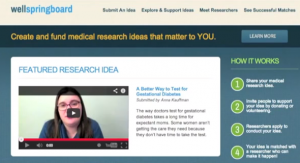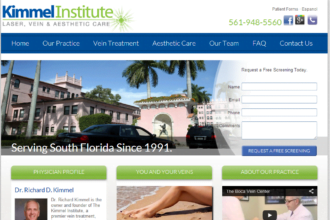 I wrote my first patient portal site, built into my first EMR software, back in 1998. At that time I mistakenly thought that portals would take off and patients would embrace them. What I quickly learned was that patient portals aren’t really portals in the sense of Yahoo! or Google but enterprise software’s customer-facing front-ends.
I wrote my first patient portal site, built into my first EMR software, back in 1998. At that time I mistakenly thought that portals would take off and patients would embrace them. What I quickly learned was that patient portals aren’t really portals in the sense of Yahoo! or Google but enterprise software’s customer-facing front-ends.
 I wrote my first patient portal site, built into my first EMR software, back in 1998. At that time I mistakenly thought that portals would take off and patients would embrace them. What I quickly learned was that patient portals aren’t really portals in the sense of Yahoo! or Google but enterprise software’s customer-facing front-ends. The enterprise software in this case is of course an EHR and the customers are the patients. If patients are the consumers then their expectations are that they can conduct “business” with the practice through the portal. This means messaging, getting questions answers, scheduling appointments, reviewing all records, etc. are minimal value propositions for a patient portal.
I wrote my first patient portal site, built into my first EMR software, back in 1998. At that time I mistakenly thought that portals would take off and patients would embrace them. What I quickly learned was that patient portals aren’t really portals in the sense of Yahoo! or Google but enterprise software’s customer-facing front-ends. The enterprise software in this case is of course an EHR and the customers are the patients. If patients are the consumers then their expectations are that they can conduct “business” with the practice through the portal. This means messaging, getting questions answers, scheduling appointments, reviewing all records, etc. are minimal value propositions for a patient portal.
However, even though portals are terrific opportunities for patient engagement, most portals’ technology architecture do not provide significant enough value for patients. I reached out to Cameron Graham, Editorial Coordinator at TechnologyAdvice, about what he’s seeing in the marketplace when it comes to portals. Cameron oversees market research for healthcare IT, business intelligence, and other emerging technologies and here’s what he had to say about how vendors and clinicians can encourage patients to use their respective portals:
Patient portals have the potential to simplify practice operations and reduce physician costs, but only if patients adopt and use them. We surveyed 430 people who had recently visited their primary care doctor in order to gauge how patients wish to communicate with their physician. Here some of the key takeaways from our survey for vendors and practices.
1. Physicians need to raise awareness about patient portal availability and benefits.
In our survey, 39.9% of patients said they didn’t know whether their primary care physician offered patient portal software. Given the high rates of EHR adoption among primary care physicians, and the increasing amount of EHRs that contain integrated portals, this is likely due to a lack of marketing. The responsibility for such marketing falls on physicians. Practices should consider implementing in-office programs to walk patients through available portal software, or deliver clear instructions to them prior to an appointment. Physicians should not assume that patients will investigate their websites or find such software on their own, even if told about it. At the very least, physician’s should provide each patient with an instruction sheet at the end of an appointment. Meaningful Use stage 2 requires that five percent of a practice’s patients utilize such a service. This threshold will only rise going forward, making effective promotion of such tools even more important.
To help promote increased patient awareness, vendors should consider investing in their own marketing campaigns, outside of any physician-led campaigns. Vendor involvement with EHR and health IT software is usually limited to the installation phase. However, it is in vendor interest to encourage patient awareness of such technology. Supplying practices with marketing materials, providing post-implementation support for customers, or even compiling an online list of each practice using their software could go a long way toward boosting awareness.
2. Patients still prefer hearing from physicians by phone, rather than through a portal, but younger patients are open to online appointment scheduling.
Our results found that just 13.6 percent of patients want to be contacted through a patient portal for general communications, while 14.1 percent wish to receive lab results and diagnoses through such a site. On the other hand, 42.7 percent want their doctor to deliver test results over the phone, and 42.9 percent want to receive general communication by phone as well. These preferences were consistent between age groups, except when it came to online appointment scheduling. 63.6 percent of patients aged 18-24 said they preferred using an online calendar to schedule appointments, while only 15 percent of respondents over the age of 65 chose the same.
These results suggest that physicians and vendors need to provide more incentive for patients to use online resources, if they want to move to a digital-first practice model. This could be done through increased marketing to consumers by vendors, or through physician led campaigns touting the benefits of online systems. Alleviating any security-concerns patients may have about posting health information online will likely need to be priority in these efforts. Younger patients may also be more receptive to portals, as they already prefer to schedule their appointments online.
Vendors should also place greater emphasis on the usability and intuitiveness of their patient portal interfaces. This would lower the barrier-to-entry for patients who are unfamiliar with features such as online appointment scheduling, or digital messaging. If vendors can ensure a positive first experience, it will also encourage patients to share their experiences with others, increasing patient portal awareness.
3. Almost half of patients report that their physician did not follow up with them after their visit. This is a significant opportunity for incentivizing patient portal usage.
47.9 percent of patients reported that their physician did not follow up with them after their last visit (outside of payment invoices). Of the physician’s that did follow up with patients, only 9.1 percent did so through a patient portal. Given the importance of patient engagement in modern healthcare, this represents an area for significant improvement.
Once physicians have shown patients how to use a portal, they still need to provide incentive for them to log on. Following up with each patient through these portals (which can automatically alert the patient by email that they have a new message to view) would help accomplish this goal. One of the ways for providers to meet the patient portals requirements for MU Stage 2 incentives is to have patients send them a secure message. The post-visit follow up provides a great opportunity for physicians to accomplish this goal.
To better encourage physician-patient communication (and therefore increased patient engagement), vendors can build in more robust automation capabilities, and place a larger emphasis on this during their training. Offering best-practice guides for engagement could also be a step in the right direction. If physician’s can easily automate the follow-up procedure based on information from the patient’s visit and the electronic health record, engagement rates (and portal usage) will likely increase.
Note: You can Connect with Cameron on LinkedIn or Google+.
patient portal / shutterstock








